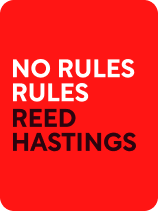

This article is an excerpt from the Shortform book guide to "No Rules Rules" by Reed Hastings. Shortform has the world's best summaries and analyses of books you should be reading.
Like this article? Sign up for a free trial here .
What is contextual leadership? How does leading with context instead of strict rules work?
Contextual leadership is a management style in which employees are equipped with the context for what is needed, but otherwise given the freedom to make appropriate decisions. The autonomy allowed is in contrast to the controls-based leadership of a company with strict rules.
Read more about contextual leadership and the conditions needed to use it in your organization.
Conditions for Contextual Leadership
Let’s look at each of the conditions you need to have in order to have a successful contextual leadership system.
Condition #1: High Talent Density
The reason that most companies lead with control boils down to a lack of trust in employees’ skill and judgment. Senior leaders must work their way up to their positions—whether within one company or through several—and along the way, they presumably earn the trust of the company to make important decisions. On the other hand, lower-level employees typically have less experience and thus present a higher risk. Furthermore, if the company hasn’t implemented the organizational transparency discussed in Chapter 6, employees may not know critical strategic and financial data that they need to make informed decisions.
By contrast, if the company has developed a high talent density, then every employee should be deserving of the trust and freedom to make decisions without oversight or controls. In the absence of controls, contextual leadership equips high-performing employees to make independent decisions. This context includes strategic and financial data as well as information about the direction in which the company is moving, which we’ll talk more about in Condition #4. When high-performing employees have the freedom to make decisions, it gives them the flexibility to be more innovative. Additionally, when employees exercise that freedom, they improve their ability to make bigger and better independent decisions in the future.
Condition #2: Emphasis on Innovation Over Error Prevention
In some industries and organizations, controls are necessary to ensure safety and accuracy. For example, ExxonMobil’s employees work on drilling sites where they could be hurt or even killed if the proper protocol isn’t followed, which makes controls and oversight critical. Similarly, vehicle manufacturers must lead with control to guarantee that their products are safe and functional.
On the other hand, if the company’s success depends more on adapting and staying relevant in a changing market, then contextual leadership is an important way to promote innovation. For example, safety risks are unlikely to put Target out of business, but if the company didn’t innovate and adapt to the growth of e-commerce, it could have shuttered like other big-box retailers.
Condition #3: A Loosely Coupled Organizational Structure
In software engineering (which is Hastings’s background), there are two ways to design systems:
- In a tightly coupled system, the various components are interconnected and, as a result, you can’t change one thing without adjusting everything else. In a company, this often means that the CEO leads by control, making decisions that are carried out by the various departments. If one department has an issue, that department manager has to discuss it with the CEO so that the rest of the departments can adapt accordingly. If you want contextual leadership in a tightly coupled organization, by definition you can’t change the structure of your team without reforming the approach of the entire company. While this limits innovation, it allows strategic changes to be uniformly implemented throughout the company.
- In a loosely coupled system, few components are interdependent, which makes it easier to change some aspects of the system without impacting the rest. In an organization, this means that lower-level managers and employees can make decisions and resolve issues without concern that their actions will have repercussions in other departments. You can only lead by context in a loosely coupled organization.
Netflix is clearly a loosely coupled company, with its informed captain model, dispersed decision-making, and few control processes. As a result, employees enjoy more freedom, departments have more flexibility, and decision-making and progress move more quickly throughout the organization. However, if the company wants to change its strategy, the loosely coupled structure makes it more difficult to keep the entire organization aligned in that shift—and that alignment is critical to successfully leading by context. A loosely coupled organization is still the better approach for innovative companies, but leaders must take care to establish alignment.
Condition #4: Company-Wide Alignment
Think of your company’s evolution as a journey with your staff. When you lead by context, you allow your employees to find their own routes—and your job is to ensure that everyone knows which direction to go. The CEO provides context to the company’s senior managers about the general direction and values of the company; Hastings does this at his Quarterly Business Review (QBR) meetings with the company’s top few hundred leaders. Those leaders use that context to give their teams another layer of context that homes in on their specific responsibilities. The process continues down to the most junior employee.
Employees can only make independent decisions in the best interest of the company’s mission and strategy if they have proper context—and when they make poor decisions, managers should refrain from blaming the employees and instead reflect on how they failed to provide adequate context. For example, Hastings discovered that a facilities executive had asked managers to predict how many employees their departments would have for the next five years. The facilities executive’s intention was to save money by using the estimates to secure office spaces that the company wouldn’t outgrow before the leases were up, as had happened in the past.
However, making predictions five years into the future in a rapidly changing market threatened to limit the company’s flexibility, which could limit innovation. If Hastings had told the facilities executive right then and there to stop working this way, he would have been leading with control. Instead, he made a note to himself to bring up the issue at the next QBR—after all, if this one manager was out of alignment with the company, it could be an indication that other employees were, too. Hastings had to set context, so at the meeting, he explained that he preferred to pay more for options that offer more flexibility. Then, attendees broke into small groups to discuss how the tradeoff between flexibility and cost had played out in the past, and how that would inform future decisions. The groups weren’t working toward a decisive answer, but the discussions helped everyone develop greater context and become aligned on the issue.

———End of Preview———
Like what you just read? Read the rest of the world's best book summary and analysis of Reed Hastings's "No Rules Rules" at Shortform .
Here's what you'll find in our full No Rules Rules summary :
- How Netflix achieved massive success in a short period of time
- The unusual business practices that have helped Netflix sustain its success
- Why Netflix fires adequate employees





